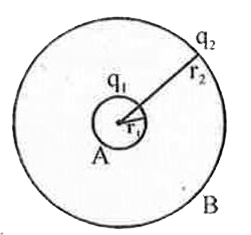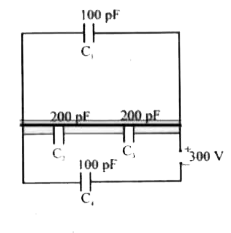Solution To Exercises From Ncert Texation from NEW JYOTHI PHYSICS (TAMIL ENGLISH) Chapter 8 ELECTROSTATIC POTENTIAL AND CAPACITANCE for Class 12
| Class 12 | PHYSICS |
| Chapter | ELECTROSTATIC POTENTIAL AND CAPACITANCE |
| NEW JYOTHI PHYSICS (TAMIL ENGLISH) | Solution To Exercises From Ncert Texation |
| Medium | English |
| Academic Year | 2023-2024 |
Question 8
In a parallel plate capacitor with air between the plates, each plate has an area of 6×10−3m2 and the distance between the plates is 3mm. Calculate the capcitance of the capacitor. If this capacitor is connected to a 100V supply, what is the charge on each plate of hte capacitor?View SolutionQuestion 15
A spherical conducting shell of inner radius r1 and outer radius r2 has a charge Q.
a. A charge 'q' is placed at the centre of the shell. What is the surface charge density on the inner and outer of the shell?
b. Is the electric field inside a cavity (with not charge) zero, even if the shell is not spherical, but has any irregular shape? Explain.View SolutionQuestion 19
If one of the two electrons of a H2 molecule is removed, we get a hydrogen molecular ion H+2. In the ground state of an H+2, the two protons are separated by roughly 1.5Å, and the electron is roughly 1Å from each proton. Determine the potential energy of the system. Specific your choice of the zero of potential energy.View SolutionQuestion 20
Two charged conducting spheres of radii a and b are connected to each other by a wire. What is the ratio of electric fields at the surfaces of the two spheres? Use the result obtained to explain why charge density on the sharp and pointed ends of a conductor is higher than on its flatter portions.View SolutionQuestion 21
Two charges -q and +q are located at points (0,0,-a) and (0,0,a) respectively.
a. What is the electrostatic potential at the points (0,0,z) and (x,y,0)?
b. Obtain the dependence of potential on the distance r of a point from the origin which ra>>1.
c. How much work is done in making a small test charge from the point (5,0,0), (-7,0,0) along the x-axis? Does the answer change if the path of hte test charge between the same points is not along the x-axis?View SolutionQuestion 23
An electrical technican requires a capacitance fo 2μF in a circuit across a potential difference of 1kV. A large number 1μF capacitor are available to him each of which can withstand a potential difference of not more than 400V. Suggest a possible arrangement that requires the minimum number of capacitors.View SolutionQuestion 24
What is the area of plates of 2F parallel capacitor, given that the separation between the plates is 0.5 cm? [You will realise from your answer why ordinary capacitors are in the range of μF or less. However, electrolytic capacitors do have a much larger capacitance (0.1F) because of very minute separation between the conductors.View SolutionQuestion 26
The plates of a parallel plate capacitor have an area of 90cm2 each and are separated by 2.5mm. The capacitor is charged by connecting it to a 400V supply.
a. How much electrostatic energy is stored by the capacitor?
b. View this energy as stored in hte electrostatic field between the plates, and obtain the energy per unit volume u. Hence arrive at a relation between u and the magnitude of electric field E between the plates.View SolutionQuestion 29
A spherical capacitor has an inner sphere of radius 12cm and an outer sphere of radius 13cm. The outer sphre is earthed the inner sphere is given a charge of 2.5μC. The space between the concentric spheres is filled with a liquid of dielectric constant 32.
a. Determine hte capacitance of the capacitor.
b. What is the potential of hte inner sphere?
c. Compare the capacitance of this capacitor with that of an isolated sphere of radius 12cm. Explain why the latter is much smaller.View SolutionQuestion 30
Two large conducting spheres carrying charges Q1,andQ2, are brought close to each other. Is the magnitude of electrostatic force between theme exactly given by Q1Q24πε0r2, where r is the distance between their centres?
b. If Coulomb's law involved 1r3 dependence (instead of 1r2), would Gauss law be still true?
c. A small test charge is released at rest at a point in an electrostatic field configuration. Will it travel along the field line passing through that point?
d. What is the work done by the field of a nucleus in a complete circular orbit of the electron? What if the orbit is elliptical?
e. We know that electric field is discontinuous across the surface of a charged conductor. Is electric potential also discontinuous there?
f. What meaning would you give to the capacitance of a single conductor?
g. Guess a possible reason why water has a much greater dielectric constant (=80) than say, mica (= 6).View SolutionQuestion 31
A cylindrical capacitor has two co-axial cylinders of length 15 cm and radii 1.5 cm and 1.4 cm. The outer cylinder is earthed and the inner cylinder is given a charge or 3.5 μC. Determine the capacitance of the system and the potential of the inner cylinder. Neglect end effects (i.e., bending of field lines at the ends).View SolutionQuestion 32
A parallel plate capacitor is to be designed with a voltage rating 1kV, using a maeterial of dielectric constant 3 and dielectric strength about 107Vm−1, (Dielectric strength is the maximum electric field a material can tolerate without breakdown, i.e, without starting to conduct electricity through partial ionisation.) For safety, we should like the field never to exceed say 10% of the dielectric strength. What minimum area of the plates is required to have a capacitance of 50pF?View SolutionQuestion 33
Describe schematically the equipotential surfaces corresponding to
a. a constant electric field in the z-direction.
b. a field that uniformly increases in magnitude but remains in a constant (say,z) direction.
c. a single positive charge at the origin, and
d. a uniform grid consisting of long equally spaced parallel charged wires in a plane.View SolutionQuestion 34
In a Van de Graaff type generator, a spherical metal shell is to be a 15×106V electrode. The dielectric strength of the gas surrounding the electrode is 5×107Vm−1. What is the minimum radius of the spherical shell required? (You will learn from this exercise why one cannot build an electrostatic generator using a very small shell which requires a small charge to acquire a high potential.)View SolutionQuestion 35
A small sphere of radius r1 and charge q1 is enclosed by a spherical shell of radius r2 and charge q2. Show that if q1 is positive, charge will necessarily flow from the sphere to the shell (when the two are connected by a wire) no matter what the charge q2, on the shell is. View Solution
View SolutionQuestion 36
a. The top of the atmosphere is at about 400 kV with respectto the surface of the earth, corresponding to an electric field that decreases with altitude. Near the surface of the earth, the field is about 100Vm−1. Why then do we not get a electric shock as we step out of our house into the openy (Assume the house to be a steel cage so there is no field inside!)
b. A man fixes outside his house one evening a two metre high insulating slab carrying on its top a large aluminium sheet of area 1m2. Will he get an electric shock if he touches the metal sheet next morning?
c. The discharging current in the atmosphere due to the small conductivity of air is known to be 1800A on an average over the globe. Why then does the atmosphere not discharge itself completely in due course and become electrically neutral? In other words, what keeps the atmosphere charged?
d. What are the forms of energy into which the electrical energy of the atmosphere is dissipated during a lightning? (Hint: The earth has an electric field of about 100Vm−1 at its surface in the downward direction, corresponding to a surface charge density =−10−9Cm−2?. View Solution


